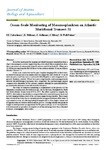Ocean-Scale Monitoring of Mesozooplankton on Atlantic Meridional Transect 21
| dc.contributor.author | Culverhouse, Phil | |
| dc.contributor.author | Williams, R | |
| dc.contributor.author | Gallienne, C | |
| dc.contributor.author | Tilbury, J | |
| dc.contributor.author | Wall-Palmer, D | |
| dc.date.accessioned | 2016-10-07T10:18:04Z | |
| dc.date.available | 2016-10-07T10:18:04Z | |
| dc.date.issued | 2016-10-14 | |
| dc.identifier.issn | 2381-0750 | |
| dc.identifier.issn | 2381-0750 | |
| dc.identifier.uri | http://hdl.handle.net/10026.1/5579 | |
| dc.description.abstract |
An in-flow instrument for imaging and identifying meso-zooplankton from a ship’s clean pumped sea water supply, from 6m, is described. Meso-zooplankton abundance was measured continuously, from 38 transects and 36 net hauls (0 - 200m), on a 13,500 km passage from the Bay of Biscay to the southern Atlantic Ocean on Atlantic Meridian Transect 21. A Line scan camera was used to give complete imaging of the in-flow water, in contrast to normal area scan cameras that sub-sample the flow. A total of 474 m³ of water was processed from transects and nearly 600,000 particles were imaged and categorized. Similarly, a total of 1901 m³ were processing from the early morning net hauls and over 300,000 biological specimens were categorized. The small and large copepod categories were dominated by the calanoid copepods although the most abundant harpacticoid in the 6m transect was Microsetella norvegica. The value of underway monitoring is demonstrated by the presence of the filamentous cyanobacteria Trichodesmium spp., for the first time, throughout the North and South Atlantic Oceans from 48°N to 46°S. The effort required to complete the AMT 21 data analysis should allow ecological data to be extracted from net hauls and in-flow pumping within a week of the specimen images being available. This is more than a factor of ten faster than is currently possible using purely human effort alone. It is presented as a way of collecting biological samples that is faster, higher volume and at a greatly reduced cost to an entirely manual process. The large number and quality of images recorded provides an opportunity for the genera and species of much plankton to be determined by specialists. A complete set of data and images have been submitted to British Oceanographic Data Centre. | |
| dc.format.extent | 1-13 | |
| dc.language.iso | en | |
| dc.publisher | Ommega Online Publishers | |
| dc.title | Ocean-Scale Monitoring of Mesozooplankton on Atlantic Meridional Transect 21 | |
| dc.type | journal-article | |
| plymouth.issue | 1 | |
| plymouth.volume | 2 | |
| plymouth.publication-status | Published online | |
| plymouth.journal | JOURNAL OF MARINE BIOLOGY AND AQUACULTURE | |
| dc.identifier.doi | 10.15436/2381-0750.16.018 | |
| plymouth.organisational-group | /Plymouth | |
| plymouth.organisational-group | /Plymouth/Faculty of Science and Engineering | |
| plymouth.organisational-group | /Plymouth/Faculty of Science and Engineering/School of Engineering, Computing and Mathematics | |
| plymouth.organisational-group | /Plymouth/Faculty of Science and Engineering/School of Geography, Earth and Environmental Sciences | |
| plymouth.organisational-group | /Plymouth/Research Groups | |
| plymouth.organisational-group | /Plymouth/Research Groups/Marine Institute | |
| dcterms.dateAccepted | 2016-09-09 | |
| dc.identifier.eissn | 2381-0750 | |
| dc.rights.embargoperiod | No embargo | |
| rioxxterms.versionofrecord | 10.15436/2381-0750.16.018 | |
| rioxxterms.licenseref.uri | http://www.rioxx.net/licenses/all-rights-reserved | |
| rioxxterms.licenseref.startdate | 2016-10-14 | |
| rioxxterms.type | Journal Article/Review |


